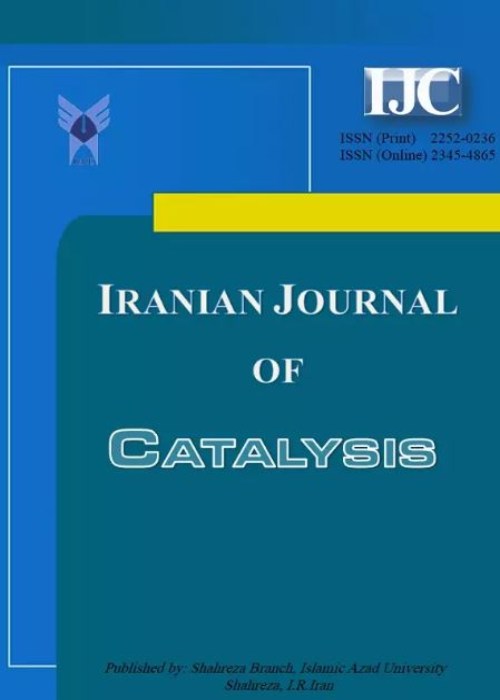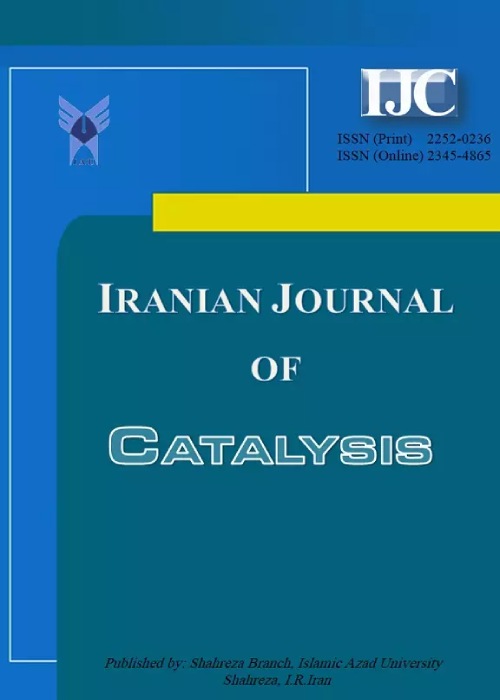فهرست مطالب

Iranian Journal of Catalysis
Volume:13 Issue: 1, Winter 2023
- تاریخ انتشار: 1401/12/10
- تعداد عناوین: 10
-
-
Pages 1-21
Organic dyes are among the main sources of water pollution that cause serious health problems for living organisms. Removing dye pollution from water sources is important because of its high toxicity, so it has attracted the interest of researchers. Heterogeneous photocatalysis based on ZnO is one of the most important methods of pollution treatment. The purpose of this review is to summarize the use of ZnO nanostructure and ZnO modified as photocatalysts. The studied mechanism of dye photocatalytic activity and the most important factors affecting the photocatalytic process are discussed. The major effective parameters associated with the surface and morphology to look upon for the efficient photodegradation of organic pollution are structural and average particle size, surface area, band gap crystalline structure, surface density, and porosity. The photodegradation reactions depend on the state of ionization as well as on the surface charge of the photocatalyst and organic dye because pH will determine the charge of the catalyst according to the medium. On the other hand, the calcination temperature was increased throughout the work to break down the pores, which reduces the surface area of the synthesis photocatalyst. The type of dye has an important influence on the success of the photocatalytic process.
Keywords: ZnO, Photocatalytic Activity, Organic dyes, Photodegradation -
Pages 23-34This study investigates the effect of a combination of copper and magnesium oxide nanoparticles embedded in a Polyvinyl chloride (PVC) matrix on photocatalytic activity. A thin film of CuO/MgO/PVC nanocomposites (NCs) was synthesized using the sol-gel route. Different weight percentages of CuO/MgO nanocomposites (5% and 15%) incorporated in the PVC matrix were deposited on glass strips using the spin coating method. The characterization of these thin films were carried out by a series of analytical and spectroscopic tools including PXRD, AFM, UV-Vis, and FTIR spectra analysis. The bandgap energy of MgO/PVC significantly reduced from 4.00 eV to 3.77 eV in 15% CuO/MgO/PVC NCs. This study also demonstrates the high ability of CuO/MgO/PVC thin films towards the photodegradation of methylene blue (MB) dye with a proposed reaction mechanism. A comparative analysis for the photodegradation of MB dye revealed superior photocatalysis by 15%with a rate constant of 5.20 × 10-3 min-1 showing about 44% efficiency. The credit goes to the decrease in the band gap, enhancement in charge separation, and increase in surface area of thin film CuO/MgO/PVC NCs.Keywords: Polyvinyl chloride, Matrix, CuO, MgO Nanocomposites, sol-gel, Photocatalysis
-
Pages 35-45In this study, the preparation of layered double hydroxide-metal oxide (ZnAl-ZnO, MgAl-ZnO, and NiAl-ZnO) was successful. The characterization of the catalyst used XRD, FTIR, and SEM analysis. The catalyst shows high oxidative desulfurization of dibenzothiophene. The percentage conversion of dibenzothiophene on ZnAl-ZnO, MgAl-ZnO, and NiAl-ZnO was 99.38%, 99.34%, and 99.90%, respectively. The acidities of ZnAl-ZnO, MgAl-ZnO, and NiAl-ZnO were 0.798, 2.469, and 0.184 mmol/g, respectively. The catalysts are heterogeneous systems, and the advantage is that they can be used for reusability. After 3 cycles of catalytic reactions at 323 K for 30 min, reusability proves that the percentage conversion of dibenzothiophene on ZnAl-ZnO, MgAl-ZnO, and NiAl-ZnO had a stable structure.Keywords: dibenzothiophene, Heterogeneous catalyst, Layered Double Hydroxide, Oxidative desulfurization, Reusability
-
Pages 47-56The 4-nitrophenol (4-NP) and methylene blue (MB) are commonly used in many industries and remain in the industrial effluent. They have an adverse effect on the environment if not treated properly. Therefore, it is essential to develop a convenient method to remove such toxic chemicals from wastewater. Here, Ag/Ag2O nanoparticles (NPs) were prepared from AgNO3 (0.05 M) using Ageratum conyzoides L. agricultural weed extract (50 mL) in an ultrasonic bath. Then, the synthesized Ag/Ag2O NPs were utilized for the 4-NP and MB reduction in the presence of NaBH4. The Ag/Ag2O NPs efficiently reduce 4-NP to 4-AP and MB to LMB in an aqueous medium. In the case of 4-NP, about 93% of the reduction was achieved in about 10 min at optimum conditions, 2 mL of 4-NP (0.15 mM) and 100 µL of NaBH4 (50 mM) in the presence of 1 mg Ag/Ag2O NPs. About 94% reduction of MB dye was achieved in about 6 min at optimum conditions, 2 mL of MB (10 ppm) and 100 µL of NaBH4 (30 mM) using 1 mg Ag/Ag2O NPs. Furthermore, the bactericidal activity of Ag/Ag2O NPs was studied against S. Mutans, B. Subtilis, and E. coli.Keywords: Ageratum conyzoides, Ag, Ag2O, Antibacterial activity, Methylene Blue, 4-nitrophenol
-
Pages 57-72An anionic, cationic, and non-ionic surfactant-assisted wet chemical method was used to synthesize vanadium pentoxide (V2O5) nanocrystals. XRD, FESEM, EDX, FTIR, UV-Vis, and PL techniques were used to characterize the V2O5 nanocrystals. The formation of V2O5 nanocrystals is confirmed by the experimental results. The addition of surfactants had a significant effect on the morphology, crystallinity, and optoelectronic characteristics of the prepared photocatalysts, as per the detailed characterization and analysis of the pertaining light-matter interactions. Additionally, the Scherrer and William-Hall plot methods were used to determine the crystallite sizes from the broadening of the XRD peak. Surfactant addition caused the sample bandgap to broaden, resulting in the blue shift in the distinctive absorption peak of V2O5 nanocrystals. To effectively separate the charge carriers during photocatalysis, the most effective photocatalyst (pure V2O5) material showed small crystallite size and short migration routes for the charge carriers which is confirmed by XRD and PL analysis. Pure V2O5 nanocrystals showed excellent yields in the photocatalytic degradation of Methylene Blue (MB) dye when exposed to sunlight compared to surfactant-assisted V2O5. The V2O5 catalyst’s photostability and reusability were also assessed; after four cycles of testing, the percentage degradation of MB was 94.75%. As per the scavenger experiment, photo-generated holes (h+) and superoxide radical’s anions (O2‾.) are the major species responsible for the degradation of MB dye. There is a suggested mechanism for the higher degradation efficiency of V2O5 at neutral pH when exposed to sunlight. Pure V2O5 is a promising and effective photo-catalyst for the photocatalytic degradation of MB dye due to its extremely high performance.Keywords: Dye degradation, Photocatalysis, surfactant, Vanadium pentoxide, Wet-chemical method
-
Pages 73-83In this research, we develop and prepare some of the polymers based on polythioesters using cetrimide as an ionic liquid and phase transfer catalyst. All of the polymers were prepared through the reaction of 5,5'-methylenebis (1,3,4-oxadiazole-2-thiol) with five types of diacyl chloride derivatives in the presence of cetrimide as phase transfer catalyst in the mixture of water and chloroform at room temperature. The chemical structure of synthesized polymers was determined using 1H NMR and 13C NMR spectroscopy. The mechanical and thermal stability of the synthesized polymers were investigated. In addition, using DFT calculation, the chemical optimization of synthesized polymers was presented. Moreover, the catalytic activity of cetrimide was compared with four types of ionic liquid with phase transfer catalyst roles. Additionally, the application of synthesized polymers in bone cement was investigated.Keywords: polymer, Ionic liquid, Phase transfer catalyst, polythioesters, Bone cement, cetrimide
-
Pages 85-90Narges Zarei was born in 1996 in Hamedan, Iran. She received her B.Sc. in Pure Chemistry (2019) and M.Sc. in Organic Chemistry (2021) from Bu-Ali Sina University under the supervision of Professor Mohammad Ali Zolfigol. She is currently working towards her Ph.D. under the supervision of Professor Mohammad Ali Zolfigol at Bu-Ali Sina University. Her research interest is the design, synthesis and characterization of magnetic nanoparticles, porous materials and urea-based compound and their catalytic applications in organic synthesis.Keywords: catalyst, Porphyrin, POPs, Porous materials
-
Pages 91-96AmirMahdi Tavassoli was born in 1994 in Malayer, Hamedan, Iran. He received his B.Sc. in Applied Chemistry (2016) from Malayer University and M.Sc. in Organic Chemistry (2020) from Bu-Ali Sina University under the supervision of Professor Mohammad Ali Zolfigol. His research interest are multicomponent reactions, synthesis of functionalized MPNs, COFs and DESs.Keywords: DESs, catalyst, Organic chemistry, green chemistry
-
Pages 97-103Elham Tavakoli was born in Ilam, Iran in 1990. She received his B.Sc. in Applied Chemistry (2014) from Payame Noor Gilan-e Gharb, Kermanshah University, Iran. She received his M.Sc. in Organic Chemistry (2018) under the supervision of Prof. Davood Azarifar from Bu-Ali Sina University, Iran. Also, she was also accepted for a Ph.D. in Organic Chemistry at the Bu-Ali Sina University under the supervision of Prof. Mohammad Ali Zolfigol (2020). Her research interest is the synthesis, characterization and applications of homogeneous and heterogeneous catalysts in organic synthesis.Keywords: Zr-based Metal-Organic Frameworks, Multi-purpose catalysts, MOFs, catalyst
-
Pages 105-111Zahra Torkashvand was born in Tehran, Iran in 1998. She received her B.Sc. in Applied Chemistry (2021) from MA layer University, Iran. She was also accepted into a M.Sc. in Organic Chemistry at the Bu-Ali Sina University in the same year under the supervision of Prof. Mohammad Ali Zolfigol. Her research interest is the synthesis, characterization, and applications of homogeneous and heterogeneous catalysts in organic synthesis.Keywords: catalyst, Cr-based MOFs, MIL-100(Cr), MOFs


